|
|
|
Sort Order |
|
|
|
Items / Page
|
|
|
|
|
|
|
| Srl | Item |
| 1 |
ID:
144333
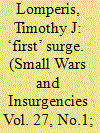

|
|
|
|
|
| Summary/Abstract |
In a military intervention, do surges work? I compare the failed ‘surge’ in Vietnam, the repulse of the Easter Invasion in 1972, as a means of assessing the more ambiguous surges in Iraq and Afghanistan. I identify four features of a surge for this analysis: the military dimensions and strategy of the surging forces, the military capabilities of the host forces, the political vitality and will of the host country, and the political commitment in the domestic politics of the intervener. I find that the last feature is the most critical; and, in all three surges, the American political commitment was lacking.
|
|
|
|
|
|
|
|
|
|
|
|
|
|
|
|
| 2 |
ID:
106000


|
|
|
|
|
| Publication |
2011.
|
| Summary/Abstract |
This paper seeks to explore how a particular narrative focused on population-centric counterinsurgency shaped American strategy during the Autumn 2009 Presidential review on Afghanistan, examine the narrative's genealogy and suggest weaknesses and inconsistencies that exist within it. More precisely our ambition is to show how through a process of 'rhetorical re-description' this narrative has come to dominate contemporary American strategic discourse. We argue that in order to promote and legitimate their case, a contemporary 'COIN Lobby' of influential warrior scholars, academics and commentators utilizes select historical interpretations of counterinsurgency and limits discussion of COIN to what they consider to be failures in implementation. As a result, it has become very difficult for other ways of conceptualizing the counterinsurgency problem to emerge into the policy debate.
|
|
|
|
|
|
|
|
|
|
|
|
|
|
|
|
| 3 |
ID:
174145
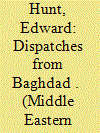

|
|
|
|
|
| Summary/Abstract |
When the dissident media group WikiLeaks published more than a quarter-million US diplomatic cables from 2010 to 2011, it included thousands of cables written by US diplomats involved in the War in Iraq (2003–2011). Although the scholarly literature covers many aspects of the war from the perspective of US officials, it has largely excluded the viewpoints captured by the WikiLeaks cables. In this article, I use the cables to reveal the thinking of US diplomats during one of the most violent phases of the war, the sectarian war, which peaked from 2006 to 2007. The cables document the sectarian cleansing of Baghdad from 2006 to 2007 and provide new information about the factors that caused the rise and fall of sectarian violence. The cables show that US actions contributed to the sectarian violence.
|
|
|
|
|
|
|
|
|
|
|
|
|
|
|
|
| 4 |
ID:
101335
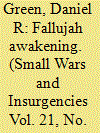

|
|
|
|
|
| Publication |
2010.
|
| Summary/Abstract |
The successful pacification of Fallujah in 2007 during the Anbar Awakening movement was due to the coordinated efforts of US and Iraqi forces to physically and psychologically separate the people from the insurgency. Efforts along security, political, and development lines along with a robust tribal effort eliminated the armed insurgency and set the basis for victory in the area. But a synchronized delivery of these resources was insufficient to defeat the insurgency by itself absent the population's decision to turn against the insurgents. This process began to occur in 2006 and was successfully capitalized upon by Coalition Forces in Fallujah in 2007.
|
|
|
|
|
|
|
|
|
|
|
|
|
|
|
|
| 5 |
ID:
089956
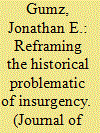

|
|
|
|
|
| Publication |
2009.
|
| Summary/Abstract |
This article explores how current professional military scholarship on insurgency and counterinsurgency (COIN) uses history to frame its arguments. It then attempts to reframe the current historical problematic surrounding insurgency. First, the article shows that the historical narrative of professional military scholarship on insurgency and its theoretical grounding are highly flawed. They are both parochial and profoundly ahistorical. Second, the paper constructs an alternative narrative of insurgency beginning from the ideas of the German legal philosopher Carl Schmitt (1888-1985), returning insurgency to history. This alternative narrative emphasizes the critical role played by the fall of European public law (jus publicum Europaeum). As a consequence of this and other historically contingent events, war in Europe lost its relative autonomy from society during the nineteenth and twentieth centuries. In turn, insurgency became an increasingly prominent and normatively accepted form of warfare by the mid-twentieth century.
|
|
|
|
|
|
|
|
|
|
|
|
|
|
|
|
| 6 |
ID:
188336
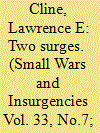

|
|
|
|
|
| Summary/Abstract |
As the strategic environments worsened both in Iraq and Afghanistan, the US tried to improve security by sharply increasing the number of troops. In the case of Iraq, the US achieved at least operational success, but the results were seemingly minimal in Afghanistan. Two factors were critical in Iraq: surge forces were focused on a relatively small center of gravity, and the operations were greatly assisted by the rise of the Awakening movement. The additional forces in Afghanistan had a much broader geographical area for their operations, and although efforts were made to mobilize local security forces, the results were at best mixed. The public time constraints on the additional forces in Afghanistan also were more prominent, leading to a ‘good enough’ approach by necessity. Although not strictly part of the surge, the US was able to turn over more security responsibilities to Iraqi forces as the ‘clear-hold-build-transfer’ process than they were to the Afghanistan forces. The results in Afghanistan in particular lead to questions as to how well expeditionary counterinsurgency forces can succeed in widespread insurgencies.
|
|
|
|
|
|
|
|
|
|
|
|
|
|
|
|
|
|
|
|
|